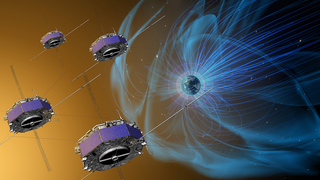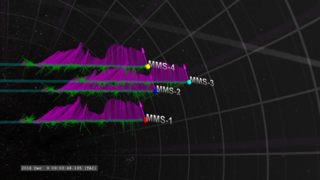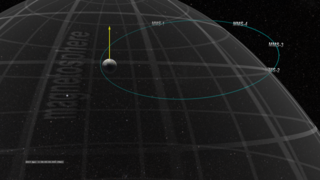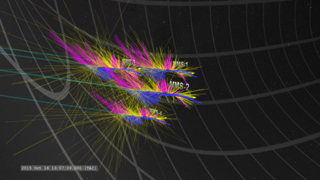Sun
ID: 4453
This visualization starts with the viewer camera just outside earth's magnetosphere (the faint grey mesh) looking down on the orbit of the four MMS spacecraft. During this portion of the mission, the apogee of the orbit takes the spacecraft just outside the magnetopause. The lower orbit speed at this location maximizes the time spent there and increases chances of catching a reconnection event which is the goal of the mission.
The camera zooms in to a chase of the four spacraft, simultaneously altering the timescale so each movie frame has a smaller time between them. We catch up with the four spacecraft and see the tetrahedral flying formation.
The MMS spacecraft are not always collecting data. Due to telemetry limitations, the data is collected in segments, at different sampling rates, and then downloaded to ground-stations on Earth. In this close-up view, we see two segments of data collection, with a short gap of no data between them.
The arrows represent the data collected by the spacecraft. To better comprehend changes as the spacecraft moves along, the data are allowed to 'echo' along the spacecraft trail. The length of the vectors represent the relative magnitude of the vector. However, the electron and proton vectors are scaled so equal velocities correspond to vectors of equal magnitude.
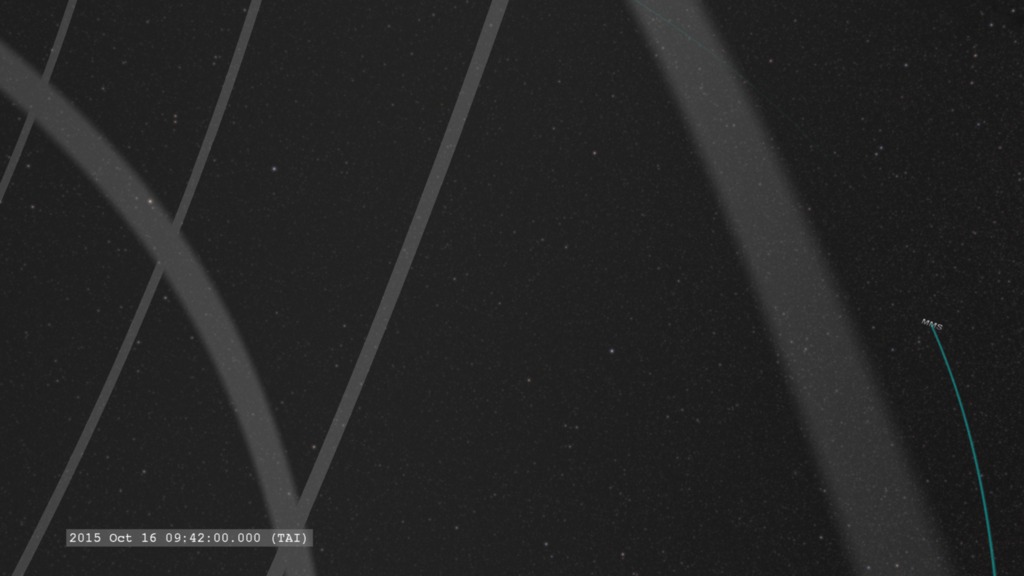
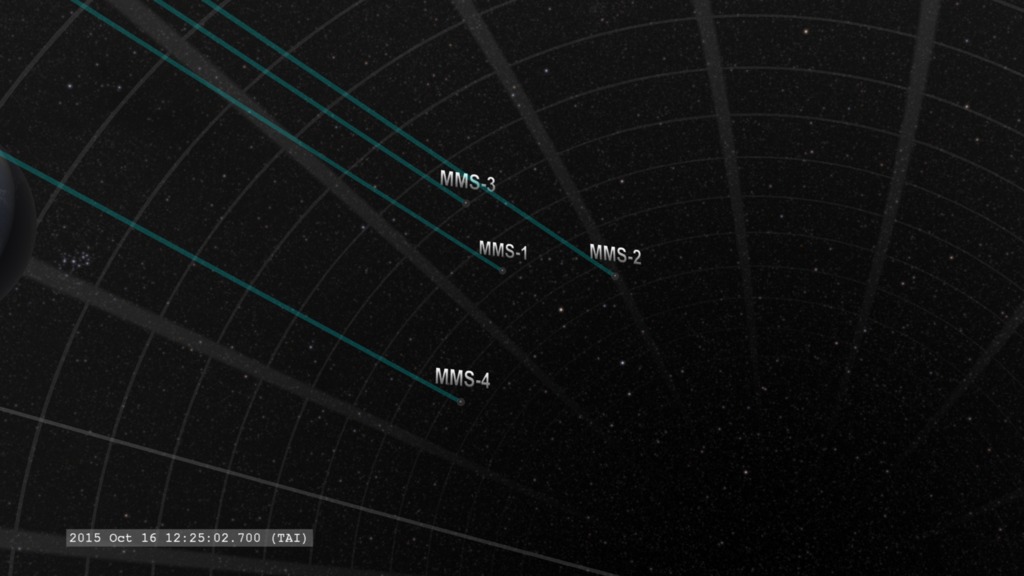


Zoom in to MMS and Magnetopause Reconnection
The camera zooms in to a chase of the four spacraft, simultaneously altering the timescale so each movie frame has a smaller time between them. We catch up with the four spacecraft and see the tetrahedral flying formation.
The MMS spacecraft are not always collecting data. Due to telemetry limitations, the data is collected in segments, at different sampling rates, and then downloaded to ground-stations on Earth. In this close-up view, we see two segments of data collection, with a short gap of no data between them.
The arrows represent the data collected by the spacecraft. To better comprehend changes as the spacecraft moves along, the data are allowed to 'echo' along the spacecraft trail. The length of the vectors represent the relative magnitude of the vector. However, the electron and proton vectors are scaled so equal velocities correspond to vectors of equal magnitude.
Magenta represents the direction and magnitude of the magnetic field at the spacecraft position. Yellow represents the direction and magnitude of the bulk motion (total average) velocity of the electrons measured at the spacecraft position. Blue represents the direction and magnitude of the bulk motion (total average) velocity of the protons measured at the spacecraft position.




Used Elsewhere In
Related
Visualization Credits
Tom Bridgman (Global Science and Technology, Inc.): Lead Visualizer
Laurence Schuler (ADNET Systems, Inc.): Technical Support
Ian Jones (ADNET Systems, Inc.): Technical Support
Genna Duberstein (USRA): Producer
Karen Fox (ADNET Systems, Inc.): Writer
Thomas Moore (NASA/GSFC): Scientist
Jim Burch (SwRI): Scientist
Paul Cassak (West Virginia University): Scientist
Steven C. Martin (ADNET): Scientific Data Support
Daniel J. Gershman (University of Maryland College Park): Scientific Data Support
Laurence Schuler (ADNET Systems, Inc.): Technical Support
Ian Jones (ADNET Systems, Inc.): Technical Support
Genna Duberstein (USRA): Producer
Karen Fox (ADNET Systems, Inc.): Writer
Thomas Moore (NASA/GSFC): Scientist
Jim Burch (SwRI): Scientist
Paul Cassak (West Virginia University): Scientist
Steven C. Martin (ADNET): Scientific Data Support
Daniel J. Gershman (University of Maryland College Park): Scientific Data Support
Please give credit for this item to:
NASA's Scientific Visualization Studio
NASA's Scientific Visualization Studio
Science Paper:
Electron-scale measurements of magnetic reconnection in space
Short URL to share this page:
https://svs.gsfc.nasa.gov/4453
Mission:
Magnetospheric Multiscale (MMS)
Data Used:
Note: While we identify the data sets used in these visualizations, we do not store any further details nor the data sets themselves on our site.
This item is part of this series:
MMS Sees Reconnection at the Magnetopause
Keywords:
SVS >> Geomagnetic Field
SVS >> Magnetic Reconnection
GCMD >> Location >> Magnetopause
SVS >> Hyperwall
SVS >> MMS
NASA Science >> Sun
GCMD keywords can be found on the Internet with the following citation: Olsen, L.M., G. Major, K. Shein, J. Scialdone, S. Ritz, T. Stevens, M. Morahan, A. Aleman, R. Vogel, S. Leicester, H. Weir, M. Meaux, S. Grebas, C.Solomon, M. Holland, T. Northcutt, R. A. Restrepo, R. Bilodeau, 2013. NASA/Global Change Master Directory (GCMD) Earth Science Keywords. Version 8.0.0.0.0
Electron-scale measurements of magnetic reconnection in space
Short URL to share this page:
https://svs.gsfc.nasa.gov/4453
Mission:
Magnetospheric Multiscale (MMS)
Data Used:
MMS/Fast Plasma Investigation also referred to as: MMS-FPI
Event List - 2015-10-16T13:03:34.003(TAI) - 2015-10-16T13:07:43.934(TAI)MMS/FIELDS also referred to as: MMS-FIELDS
Observed Data - 2015-10-16T13:03:34.003(TAI) - 2015-10-16T13:07:43.934(TAI)This item is part of this series:
MMS Sees Reconnection at the Magnetopause
Keywords:
SVS >> Geomagnetic Field
SVS >> Magnetic Reconnection
GCMD >> Location >> Magnetopause
SVS >> Hyperwall
SVS >> MMS
NASA Science >> Sun
GCMD keywords can be found on the Internet with the following citation: Olsen, L.M., G. Major, K. Shein, J. Scialdone, S. Ritz, T. Stevens, M. Morahan, A. Aleman, R. Vogel, S. Leicester, H. Weir, M. Meaux, S. Grebas, C.Solomon, M. Holland, T. Northcutt, R. A. Restrepo, R. Bilodeau, 2013. NASA/Global Change Master Directory (GCMD) Earth Science Keywords. Version 8.0.0.0.0
